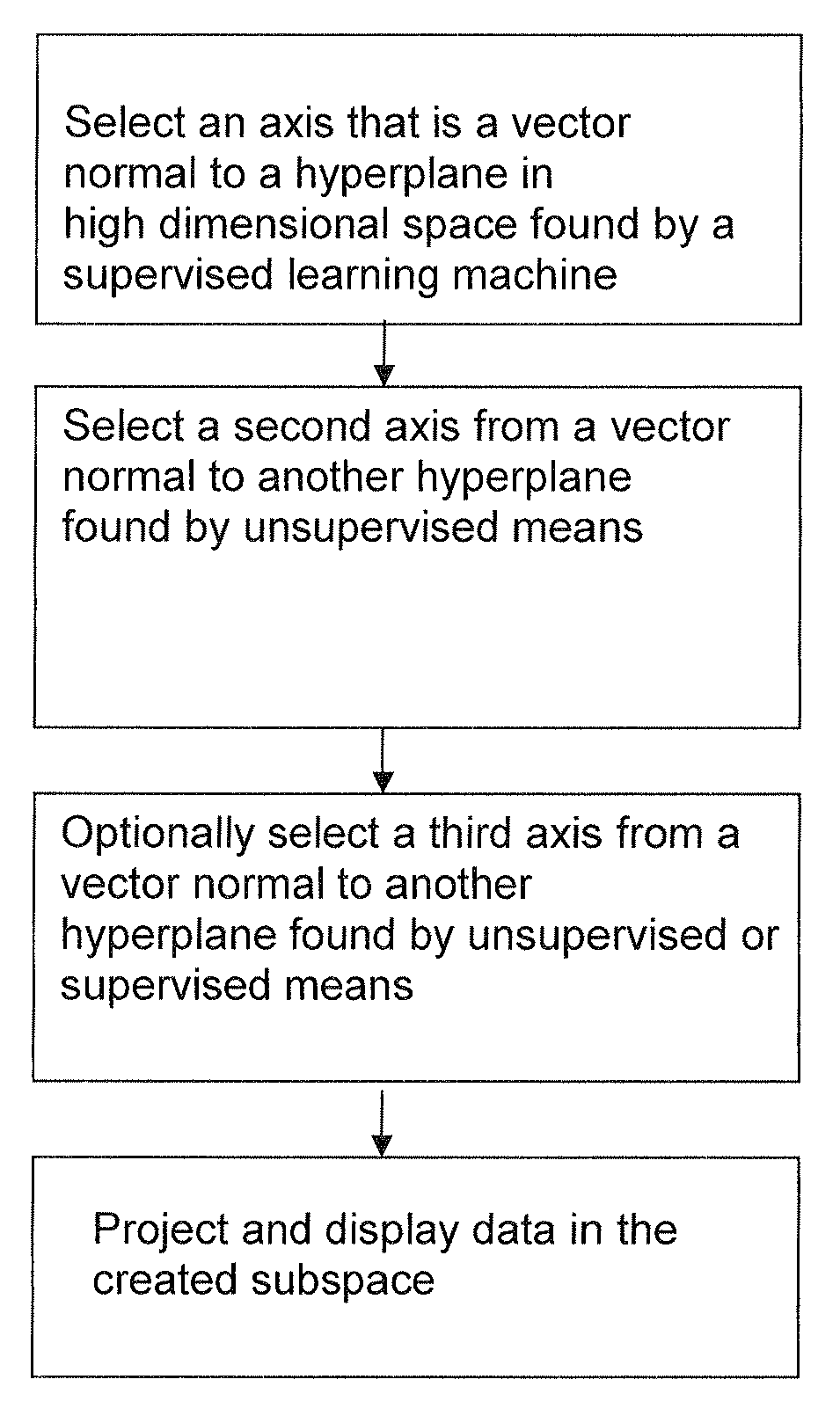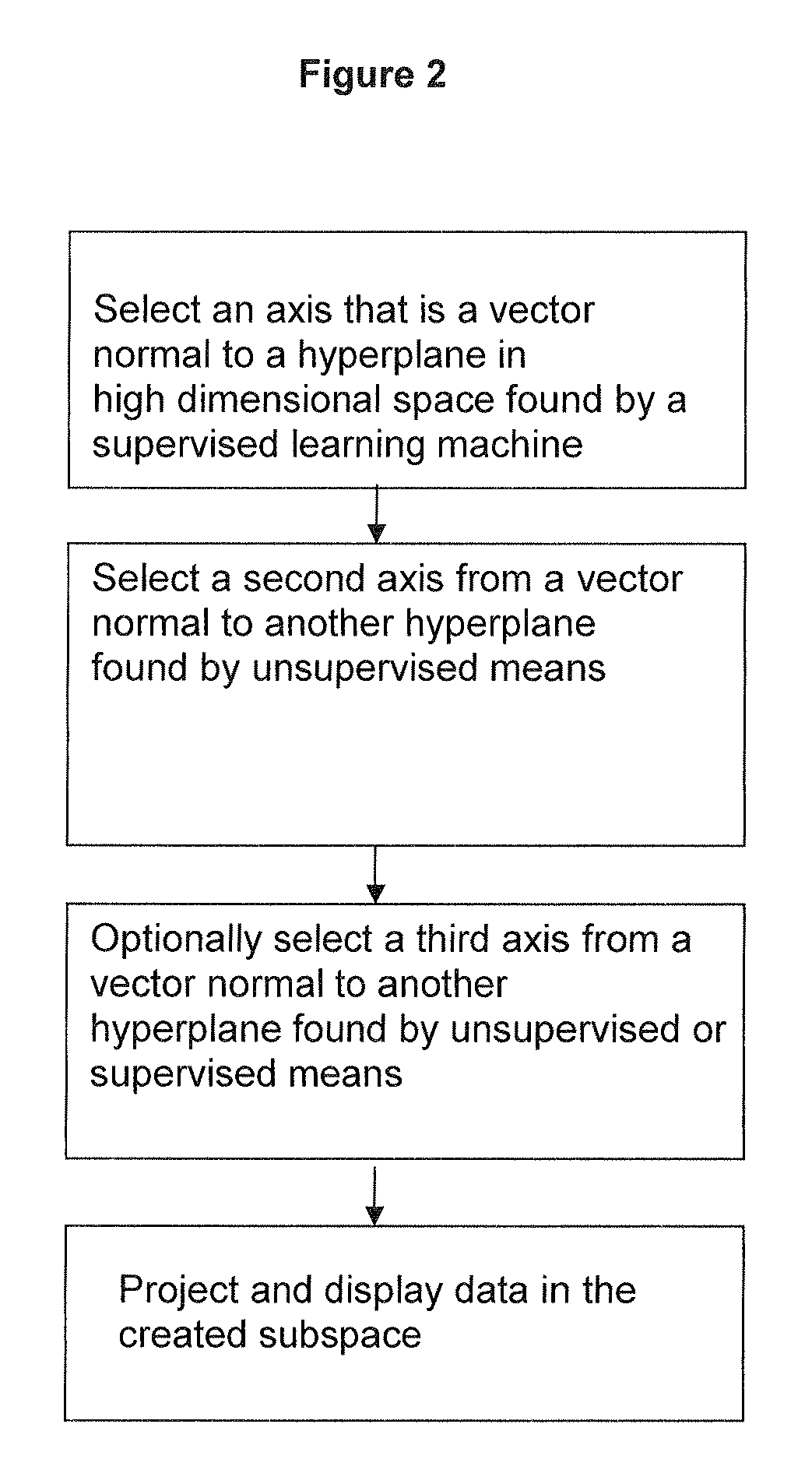Methods for mapping data into lower dimensions
a technology of data and methods, applied in the field of methods for mapping data into lower dimensions, can solve the problems of not always effectively utilized in the broader community, limited sequential access to first computer access methods, and increasing challenges, so as to facilitate the use of advanced analytical tools, facilitate discovery, and improve visualization and display. the effect of accuracy
- Summary
- Abstract
- Description
- Claims
- Application Information
AI Technical Summary
Benefits of technology
Problems solved by technology
Method used
Image
Examples
example 1
AML / ALL Data Model that Visualizes the Svm Solution and Combines Supervised and Unsupervised Methods into a Single Visual Data Model
[0144]Training data was obtained from a gene expression dataset for AML vs ALL leukemia types publicly available from the Broad Institute. This data was originally published by Golub et al, Science 286:531-537. (1999). The data contained 38 examples, 11 AML samples and 27 ALL samples, all from bone marrow of patients with the respective diseases. Training was conducted using an svm. Upon completion of training, the vector normal to the solution hyperplane was used as the x-axis. Principal components analysis was then used on the original full-featured data set. The first principal component was then ortho-normalized to the x-axis and the resulting vector used as the y-axis. The second principal component was then ortho-normalized to the first two axes and used as the z-axis.
[0145]Each example used in the training data was then represented as a point in ...
example 2
A Multiclass Alzheimer's Data Set with Visualization of Multiple Machine Learning Solutions and a Purely Supervised Model
[0150]To illustrate the use of the display method with multiple trained machines without resorting to the incorporation of any unsupervised methods to obtain visualization axes, a multi-class data set was used. Training data was obtained from the public data repository, GEO. A gene expression data set derived from postmortem brain tissue for Alzheimer's patients and patients with normal brains was used. The set consisted of 31 samples of post-mortem brain tissue in 4 classes: 9 healthy, 7 with incipient disease, 8 moderately diseased and 7 severely diseases samples. This gene expression data had been collected using Affymetrix chips containing probes for 22,215 genes as described in the journal article by Blalock et al (2004) PNAS 101 2173-2178. Each sample therefore contained levels for more than 22,000 genes.
[0151]To solve this classification problem, three clas...
example 3
Comparison of Visualization Obtained with the Current Invention to the Visualization of Unsupervised Methods Alone on a Sarcopenia Data Set
[0156]A publicly available data set was obtained from the GEO database.
[0157]Using methods available in the current state of the art, the data was analyzed using principle components analysis, and the first three principle components used to create axes. A java applet was created to visualize the results. The results presented graphically in FIG. 9. Each data example is shown as a single sphere, colored according to which of the two classes it belongs.
[0158]Next, using an svm, a separating hyperplane was found between the classes and the vector normal to it was selected as the x-axis. Principal component analysis was then used to create the second and third axes from the first and second principal components respectively. A java applet was created to visualize the results. The results are presented in FIG. 10, where each data example is shown as ...
PUM
 Login to View More
Login to View More Abstract
Description
Claims
Application Information
 Login to View More
Login to View More - R&D
- Intellectual Property
- Life Sciences
- Materials
- Tech Scout
- Unparalleled Data Quality
- Higher Quality Content
- 60% Fewer Hallucinations
Browse by: Latest US Patents, China's latest patents, Technical Efficacy Thesaurus, Application Domain, Technology Topic, Popular Technical Reports.
© 2025 PatSnap. All rights reserved.Legal|Privacy policy|Modern Slavery Act Transparency Statement|Sitemap|About US| Contact US: help@patsnap.com



